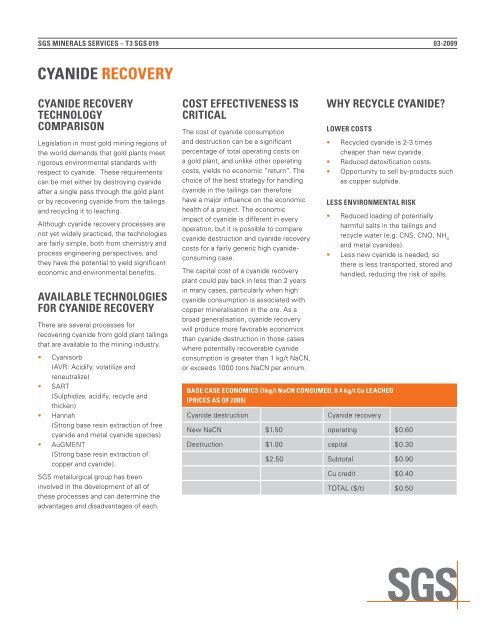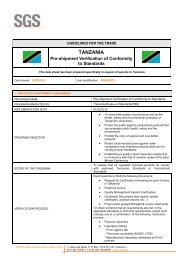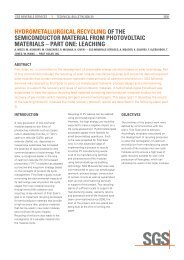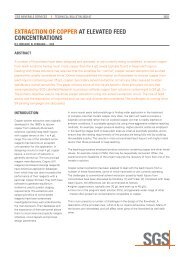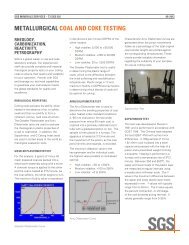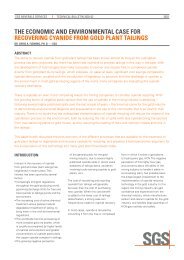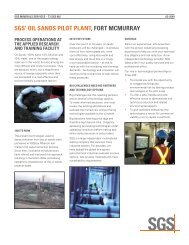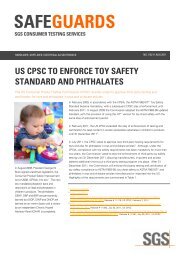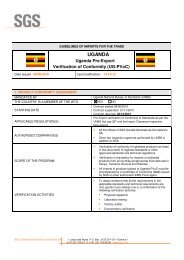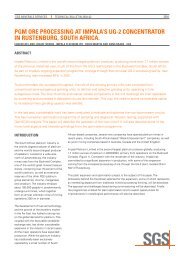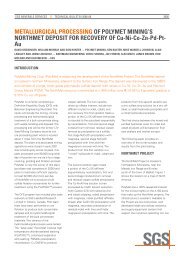You also want an ePaper? Increase the reach of your titles
YUMPU automatically turns print PDFs into web optimized ePapers that Google loves.
<strong>SGS</strong> MINERALS SERVICES – T3 <strong>SGS</strong> 019 03-2009<br />
<strong>CYANIDE</strong> <strong>RECOVERY</strong><br />
<strong>CYANIDE</strong> <strong>RECOVERY</strong><br />
TECHNOLOGY<br />
COMPARISON<br />
Legislation in most gold mining regions of<br />
the world demands that gold plants meet<br />
rigorous environmental standards with<br />
respect to cyanide. These requirements<br />
can be met either by destroying cyanide<br />
after a single pass through the gold plant<br />
or by recovering cyanide from the tailings<br />
and recycling it to leaching.<br />
Although cyanide recovery processes are<br />
not yet widely practiced, the technologies<br />
are fairly simple, both from chemistry and<br />
process engineering perspectives, and<br />
they have the potential to yield significant<br />
economic and environmental benefits.<br />
AVAILABLE TECHNOLOGIES<br />
FOR <strong>CYANIDE</strong> <strong>RECOVERY</strong><br />
There are several processes for<br />
recovering cyanide from gold plant tailings<br />
that are available to the mining industry.<br />
• Cyanisorb<br />
(AVR: Acidify, volatilize and<br />
reneutralize)<br />
• SART<br />
(Sulphidize, acidify, recycle and<br />
thicken)<br />
• Hannah<br />
(Strong base resin extraction of free<br />
cyanide and metal cyanide species)<br />
• AuGMENT<br />
(Strong base resin extraction of<br />
copper and cyanide).<br />
<strong>SGS</strong> metallurgical group has been<br />
involved in the development of all of<br />
these processes and can determine the<br />
advantages and disadvantages of each.<br />
COST EFFECTIVENESS IS<br />
CRITICAL<br />
The cost of cyanide consumption<br />
and destruction can be a significant<br />
percentage of total operating costs on<br />
a gold plant, and unlike other operating<br />
costs, yields no economic “return”. The<br />
choice of the best strategy for handling<br />
cyanide in the tailings can therefore<br />
have a major influence on the economic<br />
health of a project. The economic<br />
impact of cyanide is different in every<br />
operation, but it is possible to compare<br />
cyanide destruction and cyanide recovery<br />
costs for a fairly generic high cyanideconsuming<br />
case.<br />
The capital cost of a cyanide recovery<br />
plant could pay back in less than 2 years<br />
in many cases, particularly when high<br />
cyanide consumption is associated with<br />
copper mineralisation in the ore. As a<br />
broad generalisation, cyanide recovery<br />
will produce more favorable economics<br />
than cyanide destruction in those cases<br />
where potentially recoverable cyanide<br />
consumption is greater than 1 kg/t NaCN,<br />
or exceeds 1000 tons NaCN per annum.<br />
WHY RECYCLE <strong>CYANIDE</strong>?<br />
LOWER COSTS<br />
• Recycled cyanide is 2-3 times<br />
cheaper than new cyanide.<br />
• Reduced detoxification costs.<br />
• Opportunity to sell by-products such<br />
as copper sulphide.<br />
LESS ENVIRONMENTAL RISK<br />
• Reduced loading of potentially<br />
harmful salts in the tailings and<br />
recycle water (e.g. CNS, CNO, NH 3<br />
and metal cyanides).<br />
• Less new cyanide is needed, so<br />
there is less transported, stored and<br />
handled, reducing the risk of spills.<br />
BASE CASE ECONOMICS (1kg/t NaCN CONSUMED, 0.4 kg/t Cu LEACHED<br />
(PRICES AS OF 2005)<br />
Cyanide destruction Cyanide recovery<br />
New NaCN $1.50 operating $0.60<br />
Destruction $1.00 capital $0.30<br />
$2.50 Subtotal $0.90<br />
Cu credit $0.40<br />
TOTAL ($/t) $0.50
<strong>SGS</strong> MINERALS SERVICES – T3 <strong>SGS</strong> 019 2<br />
WHAT CAN AND CANNOT BE RECOVERED?<br />
FREE <strong>CYANIDE</strong> CYANATE<br />
Cyanide Complexes of<br />
Cu, Zn, Ni, Cd and Co 2+<br />
Thiocyanate*<br />
Cyanide Complexes of<br />
Fe and Co 3+<br />
*Thiocyante can be oxidized to regenerate the contained cyanide units, but the cost of<br />
oxidation exceeds the value of the recovered cyanide.<br />
COMPARISON OF <strong>CYANIDE</strong><br />
<strong>RECOVERY</strong> METHODS<br />
CYANISORB (AVR)<br />
The Cyanisorb process uses the wellknown<br />
AVR technique (Acidification,<br />
Volatilization and Reneutralization).<br />
Gold plant tailings are first acidified with<br />
sulphuric acid to a pH of 6-7 to convert<br />
all the free cyanide to hydrocyanic acid.<br />
The tailings are then contacted with air,<br />
in a counter-current flow, in a baffled<br />
vertical column. The HCN is stripped from<br />
the tailings into the gaseous stream, and<br />
the air/HCN stream is recycled through<br />
a second column containing a strong<br />
caustic solution. This solution absorbs<br />
the HCN gas from the air by converting<br />
it back to free cyanide ions. The air then<br />
cycles back to the stripping column. Once<br />
the caustic solution in the scrubbing<br />
column has converted to a sufficiently<br />
high cyanide strength, it is recycled to<br />
leach.<br />
The Cyanisorb process is the only<br />
commercially-practiced technology for<br />
cyanide recovery. Unifield Engineering<br />
has developed the engineering to take<br />
this process to large-scale operation.<br />
About five plants have been built over the<br />
years, but only two are currently operating<br />
worldwide today. Where plants have<br />
closed, this has been due to cessation of<br />
gold operations for one reason or another,<br />
not because of technical problems with<br />
the cyanide recovery part of the process.<br />
Advantages<br />
• Established and proven on a fairly<br />
large scale.<br />
• Can be applied to solutions or pulps,<br />
although pulps are difficult to treat<br />
and suffer high cyanide losses.<br />
Disadvantages<br />
• Only recovers free cyanide. Cyanide<br />
associated with Cu, Zn or Ni<br />
complexes must be recovered by<br />
alternative means.<br />
• Difficult to strip the final 20 to 50<br />
mg/L of cyanide from the tailings.<br />
• Stripping columns are large and<br />
costly with respect to both capex and<br />
opex. This is particularly true in the<br />
case of pulp.<br />
• Stripping columns have scaling<br />
problems and require frequent<br />
maintenance.<br />
• Large volumes of gas flow through<br />
the stripping and scrubbing columns.<br />
This HCN/air mixture is potentially<br />
hazardous, and the operation must be<br />
carefully engineered and controlled<br />
to ensure there can never be gas<br />
release.<br />
SART (SULPHIDIZATION, ACIDIFICATION,<br />
RECYCLING AND THICKENING)<br />
The SART process was developed to<br />
treat solutions containing cyanide in the<br />
form of weak acid dissociable (WAD)<br />
metal complexes (primarily copper<br />
cyanide, but also zinc or nickel cyanide).<br />
During sulphidization and acidification,<br />
the cyanide solution is treated with<br />
sulphide ions and sulphuric acid to yield<br />
a pH of 4 - 5. Under these conditions,<br />
the base metals precipitate from solution<br />
as sulphides (e.g. Cu 2 S or ZnS), leaving<br />
cyanide in solution as HCN gas. The<br />
metal sulphide precipitate is flocculated,<br />
thickened and filtered, to produce a<br />
saleable concentrate. Recycling of a<br />
portion of the thickener underflow back<br />
to the primary sulphidization/acidification<br />
reactor increase the particle size of the<br />
precipitate and improve its thickening/<br />
filtration properties. The thickener<br />
overflow and the filtrate (containing<br />
HCN gas) are treated with lime slurry to<br />
raise the pH to about 10. This converts<br />
the HCN back to free cyanide, which is<br />
recycled to leach.<br />
The SART process is especially suited<br />
to the treatment of heap leach liquors<br />
that contain elevated concentrations of<br />
base metals as WAD cyanide complexes.<br />
SART can also be used to treat the<br />
tailings from milling operations, such<br />
as CIP, CIL or Merrill Crowe barrens.<br />
However, because the SART process<br />
regenerates free cyanide at essentially<br />
the same concentration as in the tailings,<br />
the cyanide cannot be recycled without<br />
creating a water imbalance in the plant.<br />
The excess water will contain cyanide,<br />
and must be treated via a cyanide<br />
destruction process prior to discharge.<br />
The SART process was developed by<br />
<strong>SGS</strong>’ metallurgical group in collaboration<br />
with Teckcominco Corporation.<br />
Advantages<br />
• Simple to engineer and operate.<br />
• No HCN volatilization, which means a<br />
safer working environment.<br />
• Valuable by-products can be<br />
recovered.<br />
• All WAD cyanide is regenerated as<br />
free cyanide for recycle.
<strong>SGS</strong> MINERALS SERVICES – T3 <strong>SGS</strong> 019 3<br />
Disadvantages<br />
• Can only treat solutions. Therefore,<br />
the process is not well suited to<br />
the treatment of CIP or CIL tailings<br />
pulps, unless they are separated into<br />
solution and solid streams prior to<br />
cyanide recovery. In this case, the<br />
wash water introduced during solid/<br />
liquid separation must be bled from<br />
the process, and the cyanide in the<br />
bleed stream is ‘lost’.<br />
HANNAH PROCESS<br />
The Hannah process uses a strong base<br />
resin to extract and concentrate free<br />
cyanide and metal cyanide complexes<br />
from gold plant tailings solutions or pulps.<br />
The cyanide and base metals are eluted<br />
from the resin into a small, concentrated<br />
eluate stream, which is processed to<br />
remove metals as sulphide complexes,<br />
and then recycled directly to leach after<br />
neutralization with lime. The eluted resin<br />
is regenerated with acid and recycled to<br />
adsorption.<br />
The Hannah process is particularly well<br />
suited to the treatment of solutions<br />
containing copper cyanide, but it can also<br />
handle free cyanide, other metal cyanide<br />
complexes, and even the thiocyanate<br />
anion.<br />
The Hannah Process was developed by<br />
<strong>SGS</strong>’ metallurgical group and John A.<br />
Thorpe of Thorpe Consulting.<br />
Advantages<br />
• Process treats solutions or pulps with<br />
equal efficiency.<br />
• The efficiency of recovery of free<br />
cyanide and WAD cyanide complexes<br />
in tailings is very high (95 to 99%).<br />
• No HCN volatilization, resulting in a<br />
safer working environment.<br />
• Relatively simple to engineer and<br />
operate.<br />
• Valuable by-products can be<br />
generated.<br />
• No water-balance problems.<br />
Disadvantages<br />
• No known technical disadvantages.<br />
• Not operated yet at commercial<br />
scale.<br />
AUGMENT PROCESS<br />
The AuGMENT process uses a strong<br />
base resin to extract and concentrate<br />
copper cyanide from gold plant tailings<br />
solutions or pulps. AuGMENT is<br />
particularly well suited to solutions<br />
containing copper cyanide at a low CN:Cu<br />
ratio of ~3:1, although it can handle higher<br />
CN:Cu ratios by advancing resin more<br />
rapidly through the adsorption plant.<br />
Copper cyanide is partially eluted from<br />
the resin using a strong copper cyanide<br />
solution with a relatively high CN:Cu ratio<br />
(>4). The eluate is then treated in an<br />
electrowinning cell to plate copper metal<br />
and regenerate cyanide. The oxidation<br />
of cyanide in the electrowinning cell is<br />
avoided by pouching the anodes in ion<br />
exchange membrane bags. Caustic is<br />
pumped into the bags to neutralize the<br />
acid generated at the anode. A bleed<br />
stream of electrolyte/eluate is acidified to<br />
precipitate and remove copper (as CuCN)<br />
and regenerate free cyanide for recycle<br />
to leaching. The partially eluted resin is<br />
regenerated with acid and recycled to<br />
adsorption.<br />
The AuGMENT process was developed<br />
by <strong>SGS</strong>’ metallurgical group and DuPont<br />
Corporation.<br />
Advantages<br />
• Treats solutions or pulps with equal<br />
efficiency.<br />
• The efficiency of cyanide recovery<br />
from free cyanide and copper cyanide<br />
complexes in tailings is very high (95<br />
to 99%).<br />
• No HCN volatilization, resulting in a<br />
safer working environment.<br />
• Valuable by-products can be<br />
generated.<br />
• No water balance problems.<br />
Disadvantages<br />
• Operation is critically dependent on<br />
the rapid analysis and control of the<br />
cyanide to copper ratio, in adsorption,<br />
elution and electrowinning. As a<br />
result, the process will be fairly<br />
difficult to monitor, control and<br />
operate consistently and efficiently.<br />
• Vulnerable to feed composition<br />
changes.<br />
• Not yet operated on a commercial<br />
scale.<br />
THEORETICAL<br />
CONSIDERATIONS<br />
To remove cyanide and cyanide-bearing<br />
complexes from gold plant solutions, the<br />
tailings can either be treated directly, as<br />
in the Cyanisorb and SART processes,<br />
or they can be processed with an ion<br />
exchange resin prior to recovery, as in<br />
the Hannah and AuGMENT processes.<br />
The Hannah and AuGMENT processes<br />
upgrade the cyanide strength by the<br />
concentrating effect of loading onto<br />
the resin, while the Cyanisorb process<br />
upgrades the cyanide strength by the<br />
AVR process. The SART process recycles<br />
cyanide without upgrading.<br />
DIRECT TREATMENT OF CYANIDATION<br />
TAILINGS<br />
Free Cyanide<br />
If the cyanide is present in the tailings as<br />
free or weakly-complexed cyanide (pKa<br />
= 9.4), more than 99% of the cyanide is<br />
converted to HCN gas by simply lowering<br />
the pH of the tailings to about 7. The<br />
cyanide is then recovered by air-stripping<br />
of the HCN gas from the tailings into an<br />
alkaline scrubber.<br />
CN- + H+ ⇔ HCN (1)
<strong>SGS</strong> MINERALS SERVICES – T3 <strong>SGS</strong> 019 4<br />
Zinc, Copper, Nickel<br />
If, however, the cyanide is present as a<br />
metal cyanocomplex, the pH must be<br />
reduced to more acidic values (which vary<br />
with the strength of the complex) to break<br />
down the complex and produce HCN gas.<br />
The weak zinc cyanide complex (log ⇔4 =<br />
17.4), for example, dissociates completely<br />
at about pH 5, producing zinc sulphate<br />
and 4 moles of HCN. Once again, cyanide<br />
is recovered by stripping the HCN gas<br />
from the tailings in a stream of air.<br />
Zn(CN) 4<br />
2–<br />
+ 2H 2 SO 4 ⇔ ZnSO 4 + 4HCN (2)<br />
The copper cyanide complex does not<br />
break down completely even in strong<br />
acid solution, unless there is an oxidant<br />
present in the solution.<br />
In the absence of oxidant, the tricyano<br />
copper species (which is the most stable<br />
copper complex under normal cyanidation<br />
conditions: log ⇔3 = 28) decomposes to<br />
CuCN precipitate plus two moles of HCN,<br />
at pH values less than 3. Hence, a third of<br />
the potentially recoverable cyanide is lost<br />
to the precipitate.<br />
Cu(CN) 3<br />
2–<br />
+ 2H+ ⇔ CuCN + 2HCN (3)<br />
The nickel tetracyanide complex (log ⇔4 =<br />
30) also requires a pH value of less than<br />
3 to dissociate and liberate HCN gas, in a<br />
reaction equivalent to equation (2).<br />
Iron and Cobalt<br />
The very strong ferrocyanide (log ⇔6<br />
= 35), ferricyanide (log ⇔6 = 44) and<br />
cobalticyanide complexes (log ⇔6 = 64) do<br />
not break down at all, even in strong acid<br />
solutions, without destroying the cyanide.<br />
Copper and Ferrocyanide<br />
In situations where both ferrocyanide and<br />
cuprous cyanide are present in the same<br />
cyanide leach liquor (which frequently<br />
occurs with high cyanide-consuming<br />
ores), treatment of the solution with<br />
acid to pH Fe, SCN), sulphide ions can be<br />
added to the cyanide leach solution to<br />
achieve the same objective. In this case,<br />
the formation of cuprous sulphide (or<br />
synthetic chalcocite) is favored because<br />
of its extremely low solubility (Ksp = 2.3<br />
x 10-48). The following reaction takes<br />
place:<br />
2Cu(CN) 3<br />
2–<br />
+ S 2- + 6H+ ⇔ Cu 2 S +<br />
6HCN (6)<br />
This reaction is irreversible at low pH (pH<br />
<strong>SGS</strong> MINERALS SERVICES – T3 <strong>SGS</strong> 019 5<br />
prior to ion exchange, as discussed below.<br />
The ability of anion exchange resins to<br />
efficiently extract copper, zinc and nickel<br />
cyanide, as exemplified in the adsorption<br />
isotherms shown below, presents an<br />
opportunity to recover these complexes<br />
when they are present in the tailings of a<br />
gold plant.<br />
Nickel cyanide is uncommon in gold plant<br />
tailings, while cobalt and iron cyanides<br />
form such stable complexes that it is<br />
impossible to break them down without<br />
simultaneously destroying the cyanide<br />
ion. Thus, these complex anions can<br />
be efficiently extracted from gold plant<br />
tailings by ion exchange, making the<br />
tailings amenable for direct discharge to<br />
the environment, but they do not yield<br />
their cyanide for recycling<br />
Zinc Cyanide and Free Cyanide Recovery<br />
Zinc cyanide is found in many gold leach<br />
circuits, particularly those employing<br />
Merrill Crowe for final gold recovery.<br />
Although zinc cyanide is a weak complex<br />
(log ⇔4 = 17.4) and yields its cyanide ions<br />
to the stronger aurocyanide complex (log<br />
⇔2 = 38.3) during gold leaching, the build<br />
up of zinc must be controlled to minimize<br />
the total cyanide concentration in the<br />
circuit.<br />
This is usually done by taking a bleed<br />
Figure 2: The equilibrium loading of various<br />
metal cyanide complexes from a plant leach<br />
liquor onto a strong-base resin, A101Du.<br />
stream to a cyanide destruction plant.<br />
However, cyanide recovery via an ion<br />
exchange process will produce superior<br />
economics in most cases.<br />
Zinc cyanide loads onto a strong base<br />
anion exchange resin via the following<br />
stoichiometry:<br />
(® - N<br />
+<br />
R3)2 SO4 2–<br />
(® - N<br />
+<br />
R3)2Zn(CN) 4<br />
2–<br />
+ Zn(CN) 4<br />
2–<br />
⇔<br />
+ SO4 2–<br />
(7)<br />
where the symbol ® represents the resin<br />
matrix. The process is very efficient<br />
because of the great affinity of strong<br />
base resins for the zinc cyanide complex<br />
(Figure). Resins are capable of loading<br />
to capacity (30-40 g/L zinc, 50-65 g/L<br />
cyanide) from quite dilute zinc cyanide<br />
solution (5).<br />
(® - N<br />
(® - N<br />
(8)<br />
+<br />
R3)2Zn(CN) 4<br />
2–<br />
+<br />
R3)2SO4 2–<br />
+ 2H 2 SO 4 ⇔<br />
+ ZnSO 4 + 4HCN<br />
The HCN gas is volatilized from the<br />
regenerant solution in a stream of air,<br />
which is scrubbed in lime or caustic<br />
solution to recover the cyanide as the<br />
usable free cyanide ion. Because of<br />
the high concentration of HCN in the<br />
regenerant solution, the size of the<br />
stripping column will be relatively small<br />
compared to an AVR plant treating tailings<br />
solution directly.<br />
2HCN + Ca(OH) 2 Ca(CN) 2 + H 2 O (9)<br />
The barren regenerant solution can<br />
also be treated with lime or caustic to<br />
precipitate zinc hydroxide for sale, discard<br />
or recycling.<br />
ZnSO 4 + Ca(OH) 2 ⇔ Zn(OH) 2 + CaSO 4 (10)<br />
This process chemistry is also very readily<br />
applied to free cyanide recovery. The<br />
zinc hydroxide recovered by neutralization<br />
of the barren regenerant (equation 10)<br />
can be recycled back to the feed to the<br />
ion exchange plant (i.e. the gold plant<br />
barrens), where it will readily react with<br />
free cyanide ions to produce the zinc<br />
cyanide complex:<br />
Zn(OH) 2 + 4CN- ⇔ Zn(CN) 4<br />
2–<br />
+ 2OH- (11)<br />
The process chemistry then follows<br />
equations 8 to 11, and the economics are<br />
the same, as zinc is not consumed in the<br />
process.<br />
The only reagents consumed are<br />
sulphuric acid (0.5 mole per mole cyanide<br />
recovered, or 1 kg H 2 SO 4 /kg NaCN) and<br />
lime (0.5 mole per mole cyanide, or 0.75<br />
kg Ca(OH) 2 /kg NaCN).<br />
Copper Cyanide Recovery<br />
Ion exchange resins offer a unique<br />
opportunity to not only recycle the<br />
cyanide associated with the copper<br />
complex, but to also generate revenue via<br />
the sale of the copper itself. This revenue<br />
will, in many cases, offset the operating<br />
costs of the cyanide recovery plant,<br />
and the technology has the potential to<br />
transform uneconomic ore bodies into<br />
exciting opportunities.
© 2009 <strong>SGS</strong> Société Générale de Surveillance SA – All rights reserved<br />
<strong>SGS</strong> MINERALS SERVICES – T3 <strong>SGS</strong> 019 6<br />
The dominant copper cyanide species<br />
in cyanide leach solutions is the tricyano<br />
complex, which has a great affinity<br />
for strong base resins. The loading<br />
mechanism is the same as that shown<br />
above for the zinc cyanide anion:<br />
(® - N<br />
+<br />
R3)2SO4 2–<br />
2–<br />
+ Cu(CN) 3<br />
(® - N<br />
+<br />
R3)2Cu(CN) 3<br />
2–<br />
+ SO4 2–<br />
⇔<br />
(12)<br />
and the capacity of a typical, fully-loaded<br />
resin for copper (30-40 g/L) and cyanide<br />
(40-50 g/L) is also similar.<br />
However, when an acid-stripping reaction<br />
analogous to that shown in equation (8)<br />
is carried out, the copper remains in the<br />
resin phase. The reason for this is the<br />
fact that the stable precipitate CuCN<br />
is formed (equation 3), and only two<br />
moles of cyanide are released per mole<br />
of copper. When this reaction is carried<br />
CONTACT INFORMATION<br />
Email us at minerals@sgs.com<br />
www.sgs.com/mining<br />
out on copper cyanide that is loaded onto<br />
an anion exchange resin, the two moles<br />
of cyanide are liberated, but the CuCN<br />
precipitate remains trapped in the resin<br />
pores, and net copper elution efficiency<br />
is zero.<br />
(® - N<br />
(® - N<br />
+<br />
R3)2Cu(CN) 3<br />
2–<br />
+<br />
R3)2SO4 2–<br />
+ H 2 SO 4 ⇔<br />
(CuCN) + 2HCN (13)<br />
This fairly unique chemistry has been<br />
turned to advantage in the AuGMENT<br />
process, wherein CuCN is intentionally<br />
precipitated in the pores of a conventional<br />
strong base resin and, in this form,<br />
produces a regenerated resin that is an<br />
efficient adsorbent for free cyanide ions<br />
and soluble copper cyanide.<br />
Similar processes had been developed<br />
previously to recover free cyanide with<br />
CuCN precipitated in the pores of an anion<br />
exchange resin, by essentially maintaining<br />
the concentration of copper in the resin at<br />
steady state. However, these processes<br />
were unable to handle copper cyanide<br />
in the feed, as they did not incorporate<br />
a cost-effective method of eluting<br />
copper from the resin. This problem has<br />
now been overcome in the AuGMENT<br />
process, wherein copper cyanide is<br />
eluted from the resin with a strong copper<br />
cyanide solution at a relatively high CN:Cu<br />
molar ratio (~4:1). Elution is coupled with<br />
electrolysis, and the Augment process<br />
produces cathode copper.


